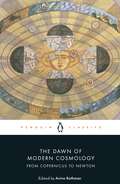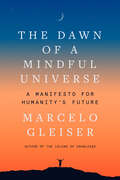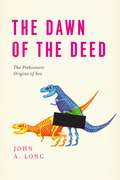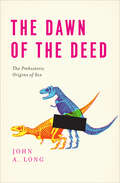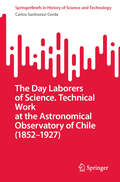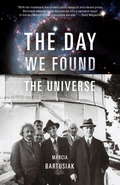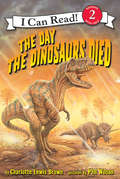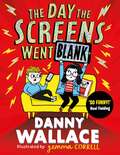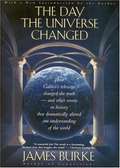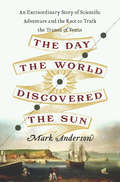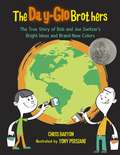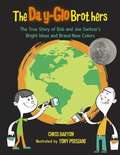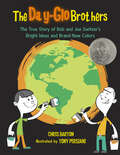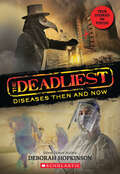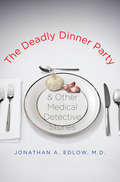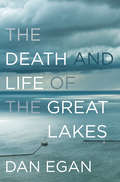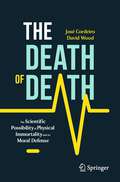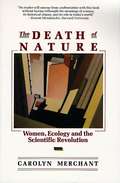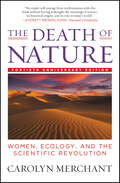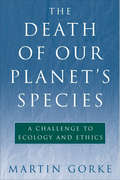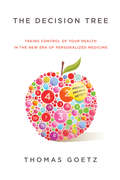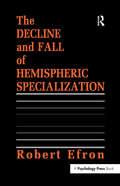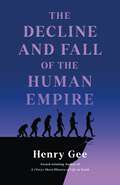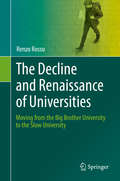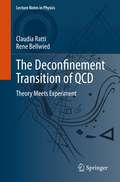- Table View
- List View
The Dawn of Modern Cosmology: From Copernicus to Newton
by René Descartes Galileo Galilei Isaac Newton Nicolaus Copernicus Johannes KeplerNew to Penguin Classics, the astonishing story of the Copernican Revolution, told through the words of the ground-breaking scientists who brought it aboutIn the late fifteenth century, it was believed that the earth stood motionless at the centre of a small, ordered cosmos. Just over two centuries later, everything had changed. Not only was the sun the centre of creation, but the entire practice of science had been revolutionised. This is the story of that astonishing transformation, told through the words of the astronomers and mathematicians at its heart. Bringing together excerpts from the works and letters of Copernicus, Galileo, Kepler, Descartes, Newton and others for the first time, The Dawn of Modern Cosmology is the definitive record of one of the great turning points in human history.Edited with Translations, Notes and an Introduction by Aviva Rothman
The Dawn of a Mindful Universe: A Manifesto for Humanity's Future
by Marcelo GleiserAn award-winning astronomer and physicist’s spellbinding and urgent call for a new Enlightenment and the recognition of the preciousness of life using reason and curiosity—the foundations of science—to study, nurture, and ultimately preserve humanity as we face the existential crisis of climate change. Since Copernicus, humanity has increasingly seen itself as adrift, an insignificant speck within a large, cold universe. Brazilian physicist, astronomer, and winner of the 2019 Templeton Prize Marcelo Gleiser argues that it is because we have lost the spark of the Enlightenment that has guided human development over the past several centuries. While some scientific efforts have been made to overcome this increasingly bleak perspective—the ongoing search for life on other planets, the recent idea of the multiverse—they have not been enough to overcome the core problem: we’ve lost our moral mission and compassionate focus in our scientific endeavors.Gleiser argues that we’re using the wrong paradigm to relate to the universe and our position in it. In this deeply researched and beautifully rendered book, he calls for us to embrace a new life-centric perspective, one which recognizes just how rare and precious life is and why it should be our mission to preserve and nurture it. The Dawn of a Mindful Universe addresses the current environmental and scientific impasses and how the scientific community can find solutions to them.Gleiser’s paradigm rethinks the ideals of the Enlightenment, and proposes a new direction for humanity, one driven by human reason and curiosity whose purpose is to save civilization itself. Within this model, we can once again see ourselves as the center of the universe—the place where life becomes conscious—and regain a clear moral compass which can be used to guide both science and the politics around it.
The Dawn of the Deed: The Prehistoric Origins of Sex
by John A. LongWe all know about the birds and the bees, but what about the ancient placoderm fishes and the dinosaurs? The history of sex is as old as life itself--and as complicated and mysterious. And despite centuries of study there is always more to know. In 2008, paleontologist John A. Long and a team of researchers revealed their discovery of a placoderm fish fossil, known as "the mother fish," which at 380 million years old revealed the oldest vertebrate embryo--the earliest known example of internal fertilization. As Long explains, this find led to the reexamination of countless fish fossils and the discovery of previously undetected embryos. As a result, placoderms are now considered to be the first species to have had intimate sexual reproduction or sex as we know it--sort of. Inspired by this incredible find, Long began a quest to uncover the paleontological and evolutionary history of copulation and insemination. In The Dawn of the Deed, he takes readers on an entertaining and lively tour through the sex lives of ancient fish and exposes the unusual mating habits of arthropods, tortoises, and even a well-endowed (16. 5 inches!) Argentine Duck. Long discusses these significant discoveries alongside what we know about reproductive biology and evolutionary theory, using the fossil record to provide a provocative account of prehistoric sex. The Dawn of the Deed also explores fascinating revelations about animal reproduction, from homosexual penguins to monogamous seahorses to the difficulties of dinosaur romance and how sexual organs in ancient shark-like fishes actually relate to our own sexual anatomy. The Dawn of the Deed is Long's own story of what it's like to be a part of a discovery that rewrites evolutionary history as well as an absolutely rollicking guide to sex throughout the ages in the animal kingdom. It's natural history with a naughty wink.
The Dawn of the Deed: The Prehistoric Origins of Sex
by John A. Long&“[A] deliciously written account of the evolution of sex, in all of its bizarre manifestations&” by a noted paleontologist—"Read, blush, and enjoy!&” (Jared Diamond, author of Guns, Germs, and Steel). We all know about the birds and the bees, but what about the ancient placoderm fishes and the dinosaurs? In 2008, paleontologist John A. Long and a team of researchers announced their discovery of a 380-million-year-old placoderm fish fossil, known as &“the mother fish,&” which revealed the earliest known example of internal fertilization. As a result, placoderms are now considered to be the first species to have had intimate sexual reproduction, or sex as we know it—sort of. Inspired by this incredible find, Long began a quest to uncover the evolutionary history of copulation and insemination. In The Dawn of the Deed, he takes readers on a lively tour through the sex lives of ancient fish and the unusual mating habits of arthropods, tortoises, and even a well-endowed Argentine Duck. Long discusses these discoveries alongside what we know about reproductive biology and evolutionary theory, using the fossil record to provide a provocative account of prehistoric sex. The Dawn of the Deed also explores fascinating revelations about animal reproduction, from homosexual penguins to monogamous seahorses to the difficulties of dinosaur romance.
The Day Laborers of Science. Technical Work at the Astronomical Observatory of Chile (SpringerBriefs in History of Science and Technology)
by Carlos Sanhueza-CerdaThis book fills a significant gap in the historiography of science by examining the overlooked contributions of non-astronomical personnel in the early National Astronomical Observatory of Chile. Drawing upon David Edgerton's critique of the bias towards academic scientists in historical narratives, this research delves into the roles of other scientists, technicians, collaborators, and other support staff in shaping scientific endeavors. The book analyzes archival documents and reveals the essential yet often unacknowledged labor involved in routine scientific tasks. By challenging the hierarchical structure of observatory organizations and spotlighting the significance of routine work, the book redefines the production of scientific knowledge beyond the conventional focus on eminent scientists. Emphasizing the importance of failures, conflicts, and controversies, this book unveils the hidden narratives of everyday scientific labor, offering a more comprehensive understanding of the history of astronomy in Chile.
The Day We Found the Universe
by Marcia BartusiakBartusiak teaches at MIT, is the award-winning author of several books, and has contributed to numerous publications including National Geographic, Smithsonian, The New York Times, and The Washington Post. In her latest text she presents an account of the discovery of the modern universe in the early-20th century. The story details the contributions made by not only Edwin Hubble but also the many talented and scientists working behind the scenes, including Henrietta Leavitt, Vesto Slipher, Georges Lemâitre, Milton Humason, and Harlow Shapley. Illustrated with b&w photographs. Academic but accessible to general readers. Annotation ©2009 Book News, Inc. , Portland, OR (booknews. com)
The Day the Dinosaurs Died (I Can Read Level 2)
by Charlotte Lewis BrownPresenting cutting-edge science to the youngest readers, The Day the Dinosaurs Died is a mesmerizing account of the end of the dinosaurs.The dinosaurs were the biggest, most powerful animals that ever walked the earth. Now they are all gone, extinct. Bold illustrations and a dramatic text re-create the devastation sixty-five million years ago when a giant asteroid slammed into Earth, triggering global disasters and leading to massive worldwide extinctions.The Day the Dinosaurs Died is a Level Two I Can Read, geared for kids who read on their own but still need a little help. Whether shared at home or in a classroom, the engaging stories, longer sentences, and language play of Level Two books are proven to help kids take their next steps toward reading success.
The Day the Screens Went Blank: The Brand-new Comedy Adventure From The Author Of The Day The Screens Went Blank
by Danny WallaceA hilarious middle-grade road-trip adventure from bestselling author, comedian, and presenter Danny Wallace, with illustrations throughout from Gemma Correll. Perfect for fans of Liz Pichon and David Baddiel! When ten-year-old Stella wakes up to discover a world full of BLANK screens, her family, town, and in fact the whole world seems to have been thrown into chaos. And what about poor Grandma who is stranded at the other end of the country? Cue a rollicking madcap road trip, full of driving disasters and family fallouts, as they set off on a rescue mission. And along the way Stella and her family discover that being away from screens might not be the Worst Thing Ever, and even though they might not be able to rely on technology anymore, they can rely on each other instead.Also by Danny Wallace:Hamish and WorldStoppers Hamish and the Neverpeople Hamish and the Gravity Burp Hamish and the Baby Boom Hamish and the Monster Patrol Hamish and the Terrible Terrible Christmas
The Day the Universe Changed
by James Lee BurkeIn The Day the Universe Changed, James Burke examines eight periods in history when our view of the world shifted dramatically: in the eleventh century, when extraordinary discoveries were made by Spanish crusaders; in fourteenth-century Florence, where perspective in painting emerged; in the fifteenth century, when the advent of the printing press shook the foundations of an oral society; in the sixteenth century, when gunnery developments triggered the birth of modern science; in the early eighteenth century, when hot English summers brought on the Industrial Revolution; in the battlefield surgery stations of the French revolutionary armies, where people first became statistics; in the nineteenth century, when the discovery of dinosaur fossils led to the theory of evolution; and in the 1820s, when electrical experiments heralded the end of scientific certainty. Based on the popular television documentary series, The Day the Universe Changed is a bestselling history that challenges the reader to decide whether there is absolute knowledge to discover - or whether the universe is "ultimately what we say it is."
The Day the World Discovered the Sun
by Mark AndersonOn June 3, 1769, the planet Venus briefly passed across the face of the sun in a cosmic alignment that occurs twice per century. Anticipation of the rare celestial event sparked a worldwide competition among aspiring global superpowers, each sending their own scientific expeditions to far-flung destinations to time the planet’s trek. These pioneers used the "Venus Transit” to discover the physical dimensions of the solar system and refine the methods of discovering longitude at sea. In this fast-paced narrative, Mark Anderson reveals the stories of three Venus Transit voyages--to the heart of the Arctic, the New World, and the Pacific—that risked every mortal peril of a candlelit age. With time running out, each expedition struggles to reach its destination-a quest that races to an unforgettable climax on a momentous summer day when the universe suddenly became much larger than anyone had dared to imagine. The Day the World Discovered the Suntells an epic story of the enduring human desire to understand our place in the universe.
The Day-Glo Brothers: The True Story of Bob and Joe Switzer's Bright Ideas And Brand-new Colors (Into Reading, Trade Book #7)
by Chris Barton Tony PersianiNIMAC-sourced textbook <P><P>A discovery that made the world a brighter place! Joe and Bob Switzer were very different brothers. Bob was a studious planner who wanted to grow up to be a doctor. Joe dreamed of making his fortune in show business and loved magic tricks and problem-solving. <P><P>When an accident left Bob recovering in a darkened basement, the brothers began experimenting with ultraviolet light and fluorescent paints. Together they invented a whole new kind of color, one that glows with an extra-special intensity—Day-Glo.
The Day-Glo Brothers: The True Story of Bob and Joe Switzer's Bright Ideas and Brand-New Colors
by Chris BartonAn illuminating tale.<P><P> Why did you pick up this book?<P> Did it have something to do with the eye-popping colors on the cover?<P> You can thank Bob and Joe Switzer for those shocking greens, blazing oranges, and screaming yellows.<P> The brothers invented a whole new kind of color--one that glowed with an extra-special intensity. It took them years of experimenting, but their efforts paid off brilliantly.<P> Day-Glo colors helped win a war, save people's lives, and brighten everyday life--including this book!<P> Winner of the Sibert Honor
The Day-Glo Brothers: The True Story of Bob and Joe Switzer's Bright Ideas and Brand-New Colors
by Chris BartonA discovery that made the world a brighter place!Joe and Bob Switzer were very different brothers. Bob was a studious planner who wanted to grow up to be a doctor. Joe dreamed of making his fortune in show business and loved magic tricks and problem-solving. When an accident left Bob recovering in a darkened basement, the brothers began experimenting with ultraviolet light and fluorescent paints. Together they invented a whole new kind of color, one that glows with an extra-special intensity—Day-Glo.This cover reproduction is not printed with Day-Glo colors. The actual book, however, is printed using three Day-Glo colors: Saturn Yellow, Fire Orange, and Signal Green.
The Deadliest Diseases Then and Now (The Deadliest)
by Deborah HopkinsonPerfect for young readers of I Survived and the Who Was series! Packed with graphics, photos, and facts for curious minds, this is a gripping look at pandemics through the ages.The deadly outbreak of plague known as the Great Mortality, which struck Europe in the mid 1300s and raged for four centuries, wiped out more than 25 million people in the course of just two years. With its vicious onslaught, life changed for millions of people almost instantaneously.Deadly pandemics have always been a part of life, from the Great Mortality of the Middle Ages, to the Spanish Influenza outbreak of 1918, to the eruption of COVID-19 in our own century. Many of these diseases might have seemed like things to read about in history books -- until the unthinkable happened, and our own lives were turned upside down by the emergence of the novel coronavirus.As we learn more about COVID-19, we may be curious about pandemics of the past. Knowing how humans fought diseases long ago may help us face those of today. In this fast-paced, wide-ranging story filled with facts, pictures, and diagrams about diseases -- from plague to smallpox to polio to flu -- critically acclaimed Sibert Honor author Deborah Hopkinson brings voices from the past to life in this exploration of the deadliest diseases of then and now. Filled with more than 50 period photographs and illustrations, charts, facts, and pull-out boxes for eager nonfiction readers.
The Deadly Dinner Party & Other Medical Detective Stories
by Jonathan A. EdlowPicking up where Berton Roueché's The Medical Detectives left off, The Deadly Dinner Party presents fifteen edge-of-your-seat, real-life medical detective stories written by a practicing physician. Award-winning author Jonathan Edlow, M. D. , shows the doctor as detective and the epidemiologist as elite sleuth in stories that are as gripping as the best thrillers. In these stories a notorious stomach bug turns a suburban dinner party into a disaster that almost claims its host; a diminutive woman routinely eats more than her football-playing boyfriend but continually loses weight; a young executive is diagnosed with lung cancer, yet the tumors seem to wax and wane inexplicably. Written for the lay person who wishes to better grasp how doctors decipher the myriad clues and puzzling symptoms they often encounter, each story presents a very different case where doctors must work to find the accurate diagnosis before it is too late. Edlow uses his unique ability to relate complex medical concepts in a writing style that is clear, engaging and easily understandable. The resulting stories both entertain us and teach us much about medicine, its history and the subtle interactions among pathogens, humans, and the environment.
The Death and Life of the Great Lakes
by Dan Egan<P>A landmark work of science, history and reporting on the past, present and imperiled future of the Great Lakes. <P>The Great Lakes—Erie, Huron, Michigan, Ontario and Superior—hold 20 percent of the world’s supply of surface fresh water and provide sustenance, work and recreation for tens of millions of Americans. But they are under threat as never before, and their problems are spreading across the continent. <P>The Death and Life of the Great Lakes is prize-winning reporter Dan Egan’s compulsively readable portrait of an ecological catastrophe happening right before our eyes, blending the epic story of the lakes with an examination of the perils they face and the ways we can restore and preserve them for generations to come. <P>For thousands of years the pristine Great Lakes were separated from the Atlantic Ocean by the roaring Niagara Falls and from the Mississippi River basin by a “sub-continental divide.” Beginning in the late 1800s, these barriers were circumvented to attract oceangoing freighters from the Atlantic and to allow Chicago’s sewage to float out to the Mississippi. These were engineering marvels in their time—and the changes in Chicago arrested a deadly cycle of waterborne illnesses—but they have had horrendous unforeseen consequences. <P> Egan provides a chilling account of how sea lamprey, zebra and quagga mussels and other invaders have made their way into the lakes, decimating native species and largely destroying the age-old ecosystem. And because the lakes are no longer isolated, the invaders now threaten water intake pipes, hydroelectric dams and other infrastructure across the country. <P>Egan also explores why outbreaks of toxic algae stemming from the overapplication of farm fertilizer have left massive biological “dead zones” that threaten the supply of fresh water. He examines fluctuations in the levels of the lakes caused by manmade climate change and overzealous dredging of shipping channels. And he reports on the chronic threats to siphon off Great Lakes water to slake drier regions of America or to be sold abroad. <P>In an age when dire problems like the Flint water crisis or the California drought bring ever more attention to the indispensability of safe, clean, easily available water, The Death and the Life of the Great Lakes is a powerful paean to what is arguably our most precious resource, an urgent examination of what threatens it and a convincing call to arms about the relatively simple things we need to do to protect it.
The Death of Death: The Scientific Possibility of Physical Immortality and its Moral Defense (Copernicus Books)
by David Wood José CordeiroIs death inevitable? Until now, the history of mankind has been marked by this fatal fact. Religions, borders and progress are born from an ancient fear of death, comfort from this fear man often found only in religious paradigms. But according to José Luis Cordeiro and David Wood, the incontrovertible fact of death is no longer an absolute certainty - science and technology are preparing to tear down the final frontier: that of immortality.This accessible book provides insight into recent exponential advances in artificial intelligence, tissue regeneration, stem cell treatment, organ printing, cryopreservation, and genetic therapies that, for the first time in human history, offer a realistic chance to solve the problem of the aging of the human body. In this book, Cordeiro and Wood not only present all the major developments, initiatives, and ideas for eternal life, they also show why there are a number of good arguments for seeing death for what it is: the last undefeated disease.Enter any drugstore or bookstore, and we confronted with a mountain of nonsense concerning the aging process. Society seems obsessed with aging. That is why The Death of Death is such a refreshing delight, able to cut through the hype and reveal a balanced, authoritative, and lucid discussion of this controversial topic. It summarizes the astonishing breakthroughs made recently in revealing how science may one day conquer the aging process.Michio Kaku, theoretical physicist and author of The God Equation: The Quest for a Theory of Everything We are entering a Fantastic Voyage into life extension, crossing different bridges that will take us to indefinite life spans. The Death of Death explains clearly how we might soon reach longevity escape velocity and live long enough to live forever. Ray Kurzweil, co-author of Fantastic Voyage: Live Long Enough to Live Forever and co-founder of Singularity University The Death of Death is a truly revolutionary book. This is a visionary book that confronts us with the terrible reality of aging, and its authors are friends and connoisseurs of the subject. I believe that the authoritative and exhaustive description of this crusade that José and David make in this excellent book will accelerate this process. Forward! Aubrey de Grey, founder of LEV (Longevity Escape Velocity) Foundation and co-author of Ending Aging
The Death of Nature: Women, Ecology and the Scientific Revolution
by Carolyn MerchantHow the scientific revolution sanctioned the exploitation of nature, commercial expansion, and the subjugation of women.
The Death of Nature: Women, Ecology, and the Scientific Revolution
by Carolyn MerchantUPDATED 40TH ANNIVERSARY EDITION WITH 2020 PREFACEAn examination of the Scientific Revolution that shows how the mechanistic world view of modern science has sanctioned the exploitation of nature, unrestrained commercial expansion, and a new socioeconomic order that subordinates women.
The Death of Our Planet's Species: A Challenge To Ecology And Ethics
by Martin GorkeThe present rate and extent of species extinction -- estimated by some scientists as one species every 20 minutes -- are unprecedented in the history of mankind. Human activities are responsible for nearly all species loss, yet ethical aspects of this crisis are rarely mentioned. Any concern expressed tends to be over potentially valuable resources -- information for scientists, or compounds that could be used in new medicines -- that are lost when a species disappears.In The Death of Our Planet's Species, Martin Gorke argues that such a utilitarian perspective is not only shortsighted but morally bankrupt. Holding doctoral degrees in both ecology and philosophy, Gorke is uniquely qualified to examine the extinction crisis from both scientific and philosophical perspectives. He offers a wide-ranging review of the literature on the subject, drawing together those two lines of reasoning that are almost always pursued separately.After critical examination of the current state of relevant ecological knowledge, Gorke presents a carefully considered case for attributing intrinsic value to all of nature, including all species. At the heart of his argument is an analysis of the concept of morality. According to this analysis, the universal character of morality does not permit us to establish limits of moral considerability. More precisely, every act of exclusion from the moral community is an arbitrary act and is not compatible with a moral point of view.The Death of Our Planet's Species sets forth a sound and original argument about the philosophical and ethical dimensions of species conservation. Throughout, the author combines a high level of theoretical sophistication with clear and straightforward writing. Orignially published in German, this Island Press edition makes The Death of Our Planet's Species available for the first time to English-speaking experts and lay readers.
The Decision Tree: How to make better choices and take control of your health
by Thomas GoetzFor all the talk about personalized medicine, our health care system remains a top-down, doctor-driven system where individuals are too often bit players in their own health decisions. In The Decision Tree, Thomas Goetz proposes a new strategy for thinking about health, one that applies cutting-edge technology to put us at the center of the equation and explains how the new frontier of health care can impact each of our lives.
The Decline and Fall of Hemispheric Specialization (Distinguished Lecture Series)
by Robert EfronProviding a personal overview of hemispheric differences in human cognitive activity, Professor Efron is selective in his presentation of significant issues. To ensure a balanced overview, references are made to many books, review articles, and research reports that present opposing positions. Although additional material has been included in this book, the informal style of the oral presentation has not been altered. This volume may be perceived as a report of one man's opinion; however, the conclusions may reflect the views of a "silent majority" of cognitive neuroscientists.
The Decline and Fall of the Human Empire: Why Our Species Is on the Edge of Extinction
by Henry GeeBy the award-winning author of A (Very) Short History of Life on Earth: a history of humanity on the brink of decline.A Next Big Idea Club Must-Read SelectionWe are living through a period that is unique in human history. For the first time in more than ten thousand years, the rate of human population growth is slowing down. In the middle of this century population growth will stop, and the number of people on Earth will start to decline - fast. In this provocative book, award-winning science writer Henry Gee offers a concise, brilliantly-told history of our species--and argues that we are on a rapid, one-way trip to extinction. The Decline and Fall of the Human Empire narrates the dramatic rise of humanity, how a scattered range of small groups across several continents eventually inbred, interacted, fought, established stable communities and food supplies, and began the process of dominating the planet. The human story is relatively brief—the oldest fossils of H. Sapiens date to approximately 300,000 years ago—yet the spread of our species has been unstoppable…until recently. As Gee demonstrates, our population has peaked, and is declining; our environment is becoming inimical to human life in many locations; our core resources of water, arable land, and air are diminishing; and new diseases, simmering conflicts, and ambiguous technologies threaten our collective health. Can we still change our course? Or is our own extinction inevitable?There could be a way out, but the launch window is narrow.Unless Homo sapiens establishes successful colonies in space within the next two centuries, our species is likely to stay earthbound and will have vanished entirely within another ten thousand years, bringing the seven-million-year story of the human lineage to an end.With assured narration, dramatic stories, and his signature sprightly humor, Henry Gee envisions new opportunities for the future of humanity—a future that will reward facing challenges with ingenuity, foresight, and cooperation.
The Decline and Renaissance of Universities: Moving from the Big Brother University to the Slow University
by Renzo RossoInstead of following the Magna Charta Universitatum, the declaration of the principles of knowledge signed in 1988 in Bologna, the academic approach pursued in Europe and the other continents over the past 30 years has strictly employed a utilitarian model of higher education. This jeopardizes academic freedom, shared governance and tenure, the three pillars of the long-established model of universities. Scientific conformism and fragmentation, educational bias and authoritarianism are the major drawbacks, together with a poor readiness to meet the emerging challenges in the labor market and technology. In this book, Renzo Rosso presents a new model for countering these developments, e.g. by establishing novel democratic rules for university governance. The Slow University paradigm positions culture and education as essential tools for the long-term survival of humankind.
The Deconfinement Transition of QCD: Theory Meets Experiment (Lecture Notes in Physics #981)
by Claudia Ratti Rene BellwiedIn the last few years, numerical simulations of QCD on the lattice have reached a new level of accuracy. A wide range of thermodynamic quantities is now available in the continuum limit and for physical quark masses. This allows a comparison with measurements from heavy ion collisions for the first time. Furthermore, calculations of dynamical quantities are also becoming available. The combined effort from first principles and experiment allows to gain an unprecedented understanding of the properties of quark-gluon plasma. This concise text, geared towards postgraduate students and newcomers to the field, carefully introduces and reviews the state-of-the-art techniques and results from lattice simulations and connects them to the experimental information from RHIC and the LHC.
